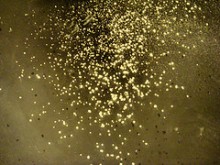
 Ladies, it’s one thing to “feel fresh,”-but another if that freshness promotes ovarian cancer. That’s the findings of several studies on women who have applied talcum powder to the external genital area or used talcum-containing genital deodorant sprays.
Ladies, it’s one thing to “feel fresh,”-but another if that freshness promotes ovarian cancer. That’s the findings of several studies on women who have applied talcum powder to the external genital area or used talcum-containing genital deodorant sprays.
According to the American Cancer Society (ACS), talcum powder particles applied to the genital area, on sanitary napkins, or on diaphragms and condoms may migrate to the ovaries where they can cause damage. A study in 1997 of 313 women with ovarian cancer and 422 without found that the women with cancer were more likely to have applied talcum powder to the external genital area or to have used genital deodorant sprays. Women using these products had a 50-90% higher risk of developing ovarian cancer. Another study in 2000 showed no effect on ovarian cancer, but a 40% increase in invasive, serious cancers. A meta-analysis in 2003 found a 33% higher risk of ovarian cancer among talc users.
The ACS says the findings aren’t considered fact just yet, but the studies are cause for concern. Unfortunately, women aren’t the only ones at risk. Talc-a mineral produced by the mining of talc rocks-can also be found in antacids, garden pesticides, some deodorants, chalk, crayons, and baby powders. In fact, according to Robert Steele, MD, writing for parenting.ivillage.com, using powders on babies to help prevent diaper rash has fallen out of favor with the medical community. “There are numerous reports of babies having life-threatening episodes from inhaling the powder,” Steele writes. “The feeling from many dermatologists is that there isn’t much advantage to powders as compared to ointments when it comes to preventing and treating diaper rash.” Mothers, too, are at risk from baby powders, as evidenced by a 1996 study by D. Heller and colleagues. They studied women who had had their ovaries removed and found traces of talc in every one, regardless of whether or not the women had applied talc to the genital area, suggesting that use of talcum powder during diapering could be the cause.
Why is talc potentially dangerous? According to the ACS, the natural form of the mineral may contain asbestos, a known human carcinogen, though all products produced after 1973 have been required by law to be asbestos-free. Even without the asbestos, however, plain talc has shown in some rodent studies (but not others) to be carcinogenic. And the particles are ground to such a small size that they are easily carried in the air, like dust, and can get into the lungs. Some worry that inhaling talcum powder may increase risk of lung cancer, as talc miners have shown higher rates of lung cancer, but science has yet to confirm this link.
Fortunately, this is a risk you can easily avoid. Simply remove any talcum powder or talc-containing products from your home. Use ointment instead of powder for diaper rash (or try this talcum-free baby powder recipe or California Baby’s Calming Non-Talc Powder), avoid perfumed genital sprays, and be careful with home & garden pesticides.
Have you found alternatives to talcum powder? Please share with us.
Photo courtesy milkywhite via Flickr.com.

